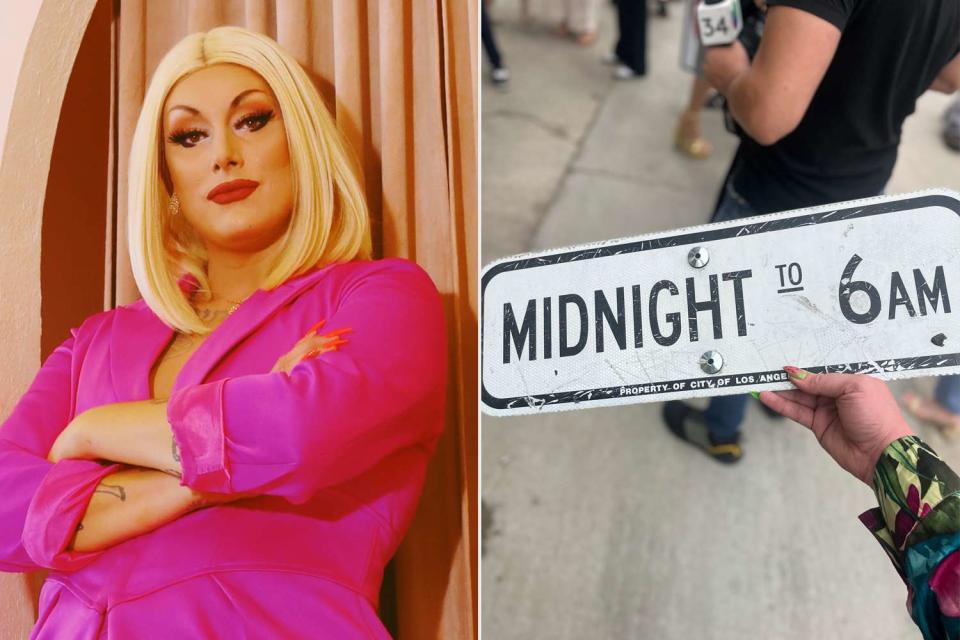Drag Queen and L.A. Public Officials Help Take Down Signs That Were Relics of City’s Anti-LGBTQ+ History
“It's just showing the queer community here in Silver Lake, and more broadly in Los Angeles, that we have your back,” Maebe A. Girl tells PEOPLE

Maebe A. Girl
Drag queen and Silver Lake Neighborhood Councilwoman Maebe A. Girl (L), who was involved in the campaign to remove the remaining signs that were reminders of her neighborhood's anti-LGBTQ+ pastThe Silver Lake Neighborhood Council implemented "No cruising" and "No U-Turn" signs in 1997 to clamp down on gay men searching for sex.
Removal of the "No cruising" signs was approved in 2011 but the other associated signs remained
A ceremony was held in Silver Lake on June 10 that finally tore down the "No U-Turn" and "Midnight to 6 a.m." signs
In the Los Angeles neighborhood of Silver Lake, road signs that were originally implemented more than 25 years ago to target members of the LGBTQ+ community have finally been removed.
On June 10, the signs featuring “No U-Turn” symbols along with placards stating "Midnight to 6 a.m." were taken down in a removal ceremony on Griffith Park Boulevard and Fernwood Avenue. Among the public officials at the event were Los Angeles City Council members Hugo Soto-Martinez and Nithya Raman.
“This type of homophobia persisted in Silver Lake 30 years after the Black Cat protests, and the physical remnants of that bigotry remained on our streets until yesterday, when we joined @nithyavraman to finally take the signs down!” Soto-Martinez wrote in a June 11 post on X.
At first glance, the signs seem to advise motorists to follow normal traffic rules. But to Maebe A. Girl, a drag queen and a member of the Silver Lake Neighborhood Council who also participated in the ceremony, the signs represented the neighborhood’s attempt in 1997 to stop gay men cruising for sex. As a result, “no cruising” signs were put into place along with the signs prohibiting U-turns during early morning hours.
But amid changing times and attitudes, the council in 2011 voted unanimously to have the ‘No cruising' signs removed, Maebe, who has served on the neighborhood council since 2019, tells PEOPLE. However, the "No U-Turn" signs remained.
“They were connected with this ‘No cruising’ ordinance,” Maebe says of the remaining signs. “Our committee took up crafting a letter in support of having the remaining ‘No cruising’ or the remaining signs affiliated with the ‘No cruising’ ordinance removed.”
Never miss a story — sign up for PEOPLE's free daily newsletter to stay up-to-date on the best of what PEOPLE has to offer, from celebrity news to compelling human interest stories.
“They were relics of the past that symbolized this era of where no cruising ordinances were used here in Silver Lake to specifically target gay people ... . So I think that's part of why I think this [issue] sort of blew up, is that a lot of people didn't quite understand how no U-turn signs could be homophobic," Maebe adds.
Another indication that the signs were targeting gay people, Maebe explains, is the “midnight to 6 a.m.” timeframe. “That's arguably the least busy time for traffic on that street,” she says. “It does get busy during rush hour when people are going [to] and from work. So if it [were] truly for traffic safety, the signs would just be in effect at all hours."
Maebe isn’t definitively sure why the other signs weren’t removed simultaneously with the "No cruising" signs following the neighborhood council vote in 2011. “My guess is the neighborhood council at the time was voting specifically on having the 'No cruising' signs removed,” she says.
The call for removing the remaining road signs gained further traction when Donovan Daughtry, a neighborhood resident, got involved after hearing a podcast that mentioned the signs, says Maebe. Daughtry then contacted City Council members Soto-Martinez and Raman, whose respective districts fall within Silver Lake.
“We had also been working on this letter of support to have the remaining signs removed,” Maebe adds. “So it sort of was serendipitous that it all came together, particularly in Pride month, to actually have the signs removed.”
Maebe posted a video clip of the June 10 sign removal event on her TikTok, which has since generated 10 million views. To her, the gesture of having the signs taken down is a recognition of Silver Lake’s rich queer history.
Related: Everything You Need to Know About Pride Month
“There's always been a number of queer bars in the area,” she says. “The area where these signs are located is just down the street from where historically there were a number of queer bars. And so queer people at the time probably felt more uncomfortable and less safe actually going to queer bars for fear of being outed, for fear of tarnishing their personal and professional reputations."
Maebe says that Silver Lake has been and will continue to be a safe haven for queer people. “It's just showing the queer community here in Silver Lake, and more broadly in Los Angeles, that we have your back,” she adds.
For more People news, make sure to sign up for our newsletter!
Read the original article on People.

 Yahoo News
Yahoo News 
